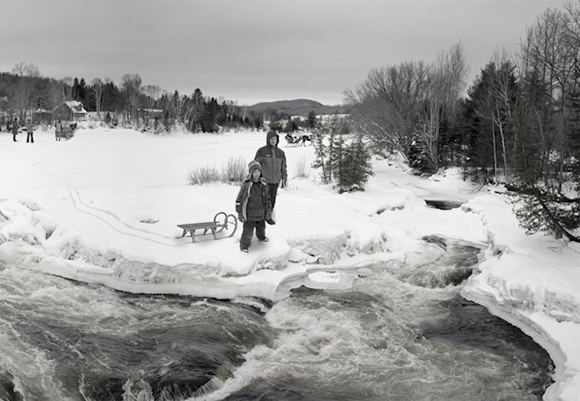Le Patrimoine is a body of work produced as a result of a Canada Council A Grant, of contemporary landscapes of rural Quebec.,
between 2006 and 2010.
Picturing Disturbance: On Le Patrimoine/Inheritance - by Randy Innes
A first glance at Le Patrimoine, Lorraine Gilbert’s recent photographic series, calls to mind the conventions of landscape and nature picturing, the visual and financial capital of tourism, and cultural typologies and exhibition. The Laurentian countryside and Mont Tremblant, a large ski resort in eastern Québec, provide the setting for the series. “Patrimoine” itself translates poorly as heritage or inheritance, and also suggests father- or home-land. Grounded firmly in the imagery and reality of Québec, Le Patrimoine is a study of the relation between history and the present, typology and artifice, economy and exploitation.
Narratives or stories begin to suggest themselves upon closer inspection of these large-scale compositions. However at the same time these photographs work hard at not being what they seem. Unlike documentary or journalistic photography, and unlike the rhetoric of landscape imagery, Gilbert’s studies seek to disturb or trouble the processes of “reading” the image.
Open Water evokes bucolic ideas of rural and historical Québec while leading the viewer’s eye to a confusing and intimidating contemporary encounter with nature. French-fry concessions meanwhile become sites for reflections on our transit along highways in search of nature and tradition, and evoke typological associations and the persistence of the natural world beneath the feet of human progress.
Sunbathers on the other hand elevates the tension between the search for pleasure and the measures we take to satisfy and profit from these urges. As a tourist destination Mont Tremblant is the embodiment of a vision of nature as something one should purchase and enjoy as a luxury item, much in the same way that Québec’s ice-fishing shacks themselves become commercial tourist destinations. While Gilbert draws attention to the tensions between wetlands, condominium development, the diurnal life of tourists, and the daily grind of those who eke out livings selling nature as a product (Chair Lift, Late Shift), Landscaping (With Crows) evokes a construction site haunted by the spectre of non-human inhabitation and framed by a visual perspective that is difficult to resolve.
Neither simply formalist monuments to an ideal or historical landscape, nor proto-romantic quests for nature, nor clear-cut social documents or documentary evidence, Le Patrimoine stimulates vision by calling attention to the processes and work involved in extracting a narrative from the embodied act of looking. Implicit in these processes is an attentiveness to the condition of the present, to the viewer’s time of looking. The viewer’s attitudes, interests and willingness to participate in the dynamic of the image helps to determine what these photographs can make visible. Whether this results in a modification of one’s aesthetic or of one’s ethical sensibilities, Le Patrimoine offers us a visual site where we may reflect upon what remains to be inherited, to whom this inheritance is destined, and the places we create for ourselves in this extended cultural narrative.
Randy Innes , February 2010
Funding this project was made possible, thanks to the Canada Arts Counsil

Open Water detail